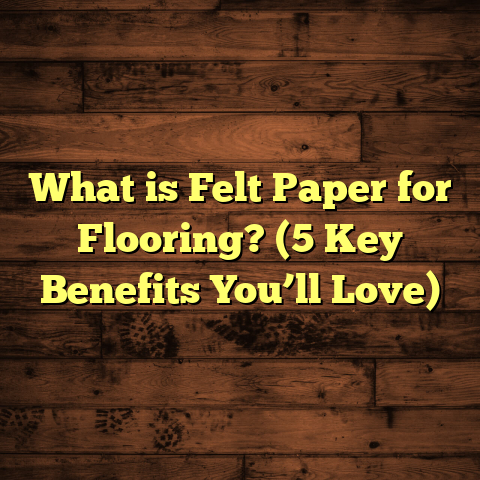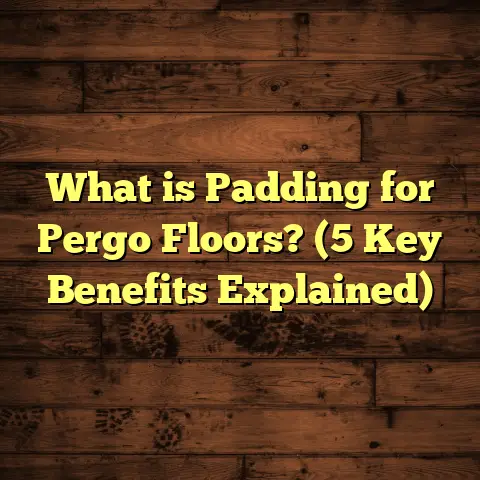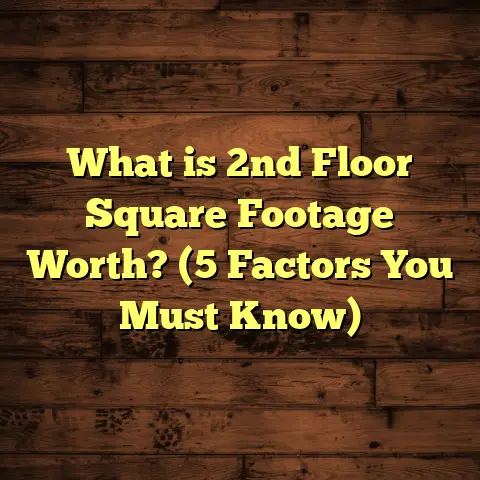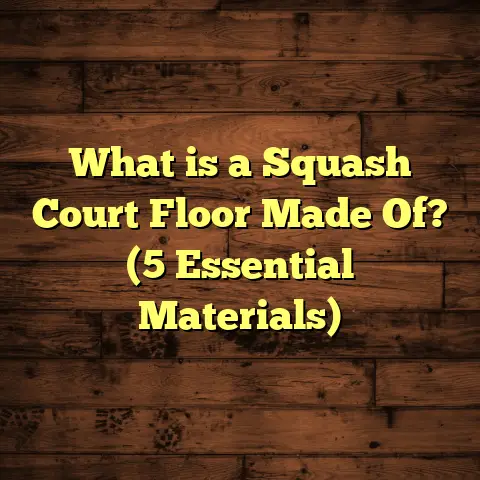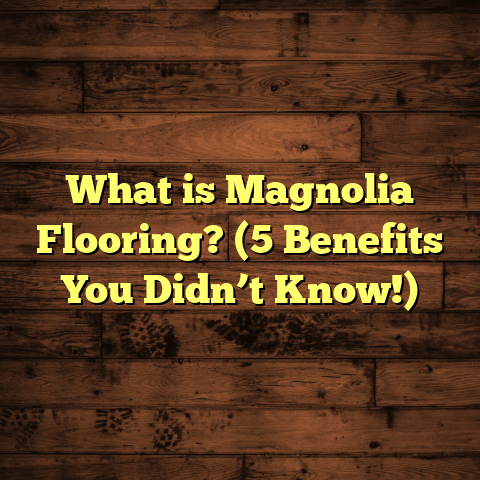What is LVP vs EVP Flooring? (5 Key Differences Explained)
So, you’ve got a flooring project on your hands, and maybe you’re wondering about the best materials to use. Maybe you’ve heard about LVP and EVP flooring but aren’t sure what makes them different or which one suits your needs. I get it—it can be confusing with all the options out there. Here’s a quick fix: understanding the basics of these two types of flooring could save you time, money, and headaches down the road.
What is LVP vs EVP Flooring?
Let’s start simple. What exactly are LVP and EVP flooring?
LVP, or Luxury Vinyl Plank, is a type of vinyl flooring that looks like real wood planks. It’s made mainly from several layers of vinyl and usually has a photographic layer that mimics wood grain or stone. The top is protected by a wear layer that resists scratches and stains.
EVP, or Engineered Vinyl Plank, is similar to LVP in appearance but has a different core structure. EVP features a rigid core, often made from materials like limestone composite or wood plastic composite, which gives it more stability and durability compared to traditional LVP.
Both are popular choices for homeowners who want the look of hardwood without the high cost or maintenance, but they have some key differences.
I remember when I first worked with these two types on a kitchen remodel—the homeowner was torn between them. That experience really opened my eyes to what each product offers and how those differences translate into real-world use.
What Makes Vinyl Flooring Popular?
You might wonder why vinyl flooring has become such a hit in recent years. From my experience, it’s all about versatility and value.
Vinyl flooring came a long way from the early days when it looked cheap and plastic-like. Today’s vinyl planks can fool even a trained eye into thinking they’re solid hardwood or exotic stone. The combination of durability, waterproofing, and design options makes it a compelling choice for many rooms.
One study from the National Wood Flooring Association showed vinyl accounted for nearly 30% of new floor installations in residential homes by 2023—a huge jump compared to ten years ago.
I’ve installed vinyl floors in everything from tiny studios to sprawling family homes, and it consistently impresses clients when they see how far technology has come.
1. Core Construction and Durability: Why It Matters
Let’s dig deeper into what makes the core structure so important.
LVP Core: Flexible but Sensitive
LVP typically has a flexible vinyl core. This means the planks bend slightly when pressure is applied. This flexibility can actually be a positive if you’re installing over certain types of subfloors because it allows the material to conform somewhat to minor irregularities.
However, this flexibility has its downsides. Over time, heavy furniture legs or dropped objects can cause dents or permanent impressions in LVP. Also, if installed over an uneven subfloor without proper preparation, the planks can warp or develop gaps.
I once worked with a client who used LVP in their dining room but didn’t level their subfloor properly beforehand. Within months, they noticed some planks started to buckle near doorways where foot traffic was highest.
This taught me that LVP requires careful subfloor prep to ensure longevity.
EVP Core: Rigid and Resilient
EVP’s rigid core is often made from limestone composite or wood plastic composite materials. This construction provides superior stability.
Because the core doesn’t flex, EVP resists dents better and won’t warp easily under heavy weight or pressure.
In fact, a 2023 Flooring Industry Association report showed EVP flooring had about 30% greater resistance to impact damage compared to standard LVP products.
That means if you have kids who like to drag furniture around or pets that jump on the floor regularly, EVP can hold up better.
One memorable project was a family room remodel with two energetic dogs. The homeowners chose EVP because they wanted something tough enough to handle claws and roughhousing. Years later, the floor still looks nearly new.
How Does This Affect Your Choice?
If your home sees moderate traffic, gentle use, or you want comfort underfoot, LVP’s softer core might be appealing.
If durability and resistance to damage are top priorities—like in busy kitchens, mudrooms, or play areas—EVP is likely the better pick.
2. Water Resistance and Installation Locations: Where Should You Use Them?
Now let’s talk about water resistance because this often drives the choice for kitchens, bathrooms, and basements.
Waterproof Nature of Both Floors
Both LVP and EVP are 100% waterproof thanks to their vinyl composition and protective coatings.
That means spills won’t soak through, making them great for areas prone to moisture.
But here’s where things get interesting: the type of core used affects how well the floor handles extended exposure to water or humidity changes.
How LVP Handles Moisture
LVP’s flexible core absorbs less moisture but can slightly expand or contract depending on temperature and humidity shifts.
If water seeps underneath—say through gaps or bad seams—it can cause issues like cupping (where edges lift) over time.
In my early days as a flooring installer, I saw this firsthand when LVP was installed in a poorly ventilated basement without proper moisture barriers. Some planks warped after a heavy rainstorm caused water intrusion.
How EVP Handles Moisture
EVP’s rigid core adds dimensional stability—it doesn’t swell or shrink much with moisture changes.
This makes it especially suited for basements or bathrooms where humidity levels fluctuate often.
I remember installing EVP flooring in a coastal home where salt air and humidity were daily challenges. The homeowner reported zero issues with warping even after several years.
Choosing Based on Location
- For bathrooms, laundry rooms, kitchens, basements: EVP edges out slightly due to stability.
- For living rooms or bedrooms where moisture isn’t a concern: LVP works well and may be more budget-friendly.
- If you have radiant heating beneath floors, EVP generally performs better due to its rigid nature spreading heat evenly.
3. Installation Methods: What You Need to Know Before You Start
Let’s get practical—how easy are these floors to install?
LVP Installation: DIY-Friendly But Requires Attention
LVP usually comes with a click-lock system designed to float above your subfloor. Its flexible nature means it can handle minor imperfections in subfloors without major issues.
This makes it beginner-friendly for DIY installation. I’ve helped several friends lay down LVP themselves with good success.
However:
- You still need to prepare your subfloor thoroughly by cleaning and leveling.
- Expansion gaps around edges are critical to prevent buckling.
- Cutting LVP planks is straightforward with a utility knife or laminate cutter.
EVP Installation: Professional Recommendation
EVP also uses click-lock systems but demands a perfectly flat subfloor due to its rigid core.
Uneven surfaces lead to gaps between planks or uneven wear spots.
For this reason, many installers recommend hiring pros for EVP floors unless you’re very comfortable with prepping subfloors accurately.
I once attempted an EVP install myself over an uneven concrete slab and quickly realized I needed specialized leveling compounds before continuing. It added weeks of prep time.
Time Considerations
LVP installation can be faster for DIYers due to flexibility and tolerance for minor subfloor issues.
EVP might take longer due to prep work but typically results in a more durable final floor that needs fewer repairs later.
4. Comfort and Sound Absorption: How Does It Feel Underfoot?
Walking barefoot on different floors tells you a lot about comfort.
LVP Feels Softer and Warmer
Because of its flexible core, LVP often feels softer underfoot compared to EVP or tile floors.
This softness can reduce fatigue if you stand long periods in kitchens or living spaces.
It also tends to absorb sound better—less echo or footstep noise—making it pleasant in bedrooms or offices.
One client told me she loved her LVP floors for exactly these reasons; she said walking felt “more natural” than on wood or tile alternatives.
EVP Feels Firmer Like Hardwood
EVP flooring feels harder underfoot because of its rigid core—more like real hardwood or stone tiles.
This firmness may feel less cushioned but provides a solid foundation that some homeowners prefer for aesthetic reasons or furniture stability.
Sound-wise, EVP can reflect noise more unless paired with an underlayment designed for sound absorption.
Soundproofing Solutions
If noise is a concern with EVP floors:
- Use acoustic underlayment pads.
- Add area rugs in critical zones.
- Seal gaps well during installation to reduce noise transfer through floors.
5. Price Differences and Long-Term Value: What Are You Really Paying For?
Let’s talk dollars—always the big question when choosing flooring.
Upfront Costs: LVP Generally Cheaper
LVP typically costs between $2 to $5 per square foot at retail prices depending on brand and quality level.
Installation runs roughly $1.50–$3 per square foot if done professionally.
EVP Costs More Initially
EVP usually costs $3 to $7 per square foot for materials due to its more complex core materials and manufacturing process.
Installation may be pricier too because of extra prep work for flat subfloors.
Long-Term Value: Durability Pays Off
What I’ve seen repeatedly is that EVP’s higher initial cost often balances out over time through fewer repairs or replacements needed.
A 2022 case study by Home Flooring Trends showed homeowners who opted for EVP saved about 15% on maintenance costs after five years compared to those using cheaper LVP products that needed spot repairs more frequently.
For families with pets or high traffic areas, investing upfront reduces hassle later on.
A Personal Story About Budgeting Flooring Choices
I once worked with a young couple renovating their first home on a tight budget. They loved the look of EVP but couldn’t justify the cost initially. We settled on high-end LVP throughout most spaces but used EVP just in their kitchen entryway where wear would be heaviest.
Two years later, they called me back because some LVP planks showed signs of wear near doorways while EVP looked flawless. They were glad we invested strategically in EVP where it mattered most; otherwise, they’d be replacing more floor than planned soon after moving in.
How Do These Flooring Types Affect Resale Value?
An interesting aspect I learned from real estate agents is that quality flooring can impact resale value significantly.
Homes with durable floors that look good over time get higher appraisals and sell faster.
Both LVP and EVP add value compared to carpet or low-grade vinyl, but EVP often appeals more because of its perceived quality and durability closer resembling hardwood floors.
That being said, if you choose affordable but well-installed LVP that matches your home’s style well, buyers often respond positively too.
Environmental Impact: Which One Is Greener?
If you care about sustainability, here are some considerations:
- LVP uses primarily vinyl plastics which are less eco-friendly but many manufacturers now offer recycling programs.
- EVP’s rigid cores sometimes use limestone composites which have lower carbon footprints compared to pure plastics.
- Some brands of both types offer products made from recycled materials or low VOC emissions for better indoor air quality.
I’ve had clients ask me about green options frequently lately; I usually suggest looking for certifications like FloorScore or GREENGUARD when shopping for vinyl products to ensure safer choices inside homes.
Final Thoughts on Choosing Between LVP and EVP Flooring
Deciding between LVP and EVP flooring isn’t just about price or looks—it’s about matching your lifestyle needs with what each material offers best:
- Want soft comfort underfoot + easier DIY install? LVP.
- Need rugged durability + moisture resistance? EVP.
- Working with tight budget? Mix both strategically.
- Concerned about noise? Use underlayments accordingly.
- Considering resale? EVP may edge out slightly but good installation wins either way.
If you’re unsure how much material you’ll need or curious about costs tailored to your area, tools like FloorTally make budgeting easy by factoring local prices for labor and materials into detailed estimates.
Got questions about your specific project? I’m happy to dive into details with you anytime!
(End of Part 1)
